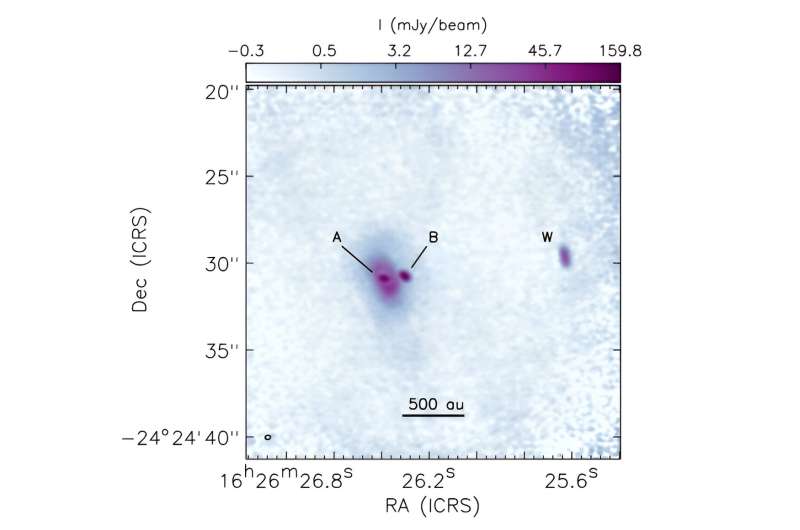June 27, 2024 report
This article has been reviewed according to Science X's editorial process and policies. Editors have highlighted the following attributes while ensuring the content's credibility:
fact-checked
preprint
trusted source
proofread
Study determines stellar mass and origin of a protostellar system

Using the Atacama Large Millimeter/submillimeter Array (ALMA), astronomers have conducted molecular line observations of a protostellar system known as VLA 1623. Results of the observational campaign, published June 18 on the pre-print server arXiv, yield new information regarding stellar mass and origin of this system.
VLA 1623 is a deeply embedded protostellar system in the star-forming region Ophiuchus A, about 456 light years away. It is one of the rare protostellar systems with detected Keplerian rotation.
The system consists of three components: VLA 1623A, VLA 1623B, and VLA 1623W. VLA 1623A is a close Class 0 binary surrounded by a circumbinary disk, with separation between the components (A1 and A2) of about 30 AU. VLA 1623B is a Class 0 protostar located some 130 AU west of VLA 1623A and associated with an edge-on disk. When it comes to VLA 1623W, it is a Class I protostar located approximately 1,300 AU west of the A binary, also associated with an edge-on disk.
Recently, a group of astronomers led by Sarah I. Sadavoy of the Queen's University in Canada, has employed ALMA to observe VLA 1623 in order to shed more light on its properties.
"We present new ALMA molecular line observations of the VLA 1623 system. We primarily focus on C17O (3–2) observations, which trace the disks of the protostars and show velocity gradients consistent with Keplerian rotation," the researchers explain.
ALMA observations allowed the team to determine the stellar masses of VLA 1623 components. It was found that VLA 1623A binary, VLA 1623B, and VLA 1623W, have masses of approximately 0.27, 1.9, and 0.64 solar masses, respectively.
The results of the new study suggest that VLA 1623W may be a companion source, and it cannot be ruled out that it is an unrelated young stellar object along the line of sight. Based on the new mass measurements and an analysis of the proper motion of the stars, the astronomers disfavor a scenario where VLA 1623W was ejected from the central core, which was suggested by previous studies.
By analyzing the collected data, the authors of the paper conclude that VLA 1623A, VLA 1623B, and VLA 1623W may have formed initially from turbulent fragmentation. However, VLA 1623A may have undergone disk fragmentation to produce a tight binary system.
When it comes to the disks in the VLA 1623 system, the observations show that the ones around VLA 1623B and VLA 1623W appear gravitationally stable. It was found that the circumbinary disk around VLA 1623A has an intermediate fraction of 20%, which may indicate instability and future fragmentation.
The observations also found that VLA 1623W appears to be unbound to the other protostars. This suggests that it may disperse in the future.
More information: Sarah I Sadavoy et al, Constraining the Stellar Masses and Origin of the Protostellar VLA 1623 System, arXiv (2024). DOI: 10.48550/arxiv.2406.12984
Journal information: arXiv
© 2024 Science X Network



















